Not to be confused with American Airlines Flight 191
Delta Air Lines Flight 191
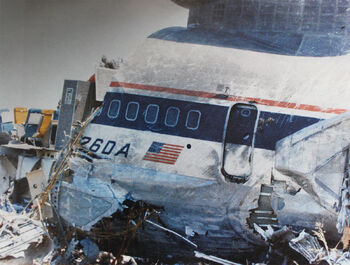
Accident
Date
Summary
Site
Time of the incident
Total fatalities
Total injuries
Flight
Aircraft model
Airline
Flight number
Call sign
Registration
Flight origin
Stopover(s)
Flight destination
Occupants
Passengers
Crew
Fatalities
Injuries
Survivors
Ground casualties
Ground fatalities
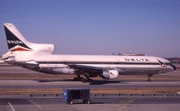
N726DA, the aircraft involved, photographed in Atlanta in February 1985.
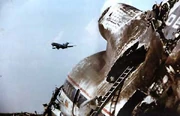
Another view of the remains as another plane approaches to land above.
On August 2, 1985, Delta Air Lines Flight 191, a Lockheed L-1011 TriStar en route from Fort Lauderdale to Los Angeles with an intermediate stop at Dallas/Fort Worth International Airport (DFW), experienced a tragic incident. While approaching DFW, the aircraft encountered a microburst, leading to its impact over one mile (1.6 km) short of therunway. The consequences were severe—the plane struck a car near the airport, collided with two water tanks, and disintegrated. Regrettably, 137 individuals lost their lives, and 25 others sustained injuries in the crash. The National Transportation Safety Board (NTSB) investigation determined that the crash was attributed to the flight crew's decision to navigate through a thunderstorm, the absence of procedures or training for microburst avoidance or escape, and the lack of hazard information regarding wind shear.[1]
Accident[ ]
Aircraft[ ]
Registered as N726DA, the Lockheed L-1011-385-1 TriStar aircraft, delivered to Delta on February 28, 1979, has maintained continuous operation since its delivery. Powering the aircraft are three Rolls-Royce RB211-22B engines.
Crew members[ ]
Comprising the crew were three flight crew members and eight cabin crew members. Unfortunately, among the 11 crew members, only three flight attendants managed to survive.
- Captain Edward Michael "Ted" Connors Jr., aged 57, achieved qualification as the TriStar's captain in 1979 after successfully passing proficiency checks. Described by past flight crews as a meticulous pilot who rigorously adhered to company policies, Connors had a record of deviating around thunderstorms, even if it meant opting for less direct routes, and was known for willingly considering suggestions from his flight crew. Since his 1979 qualification, Connors had successfully passed all eight en route inspections, receiving commendations for cockpit discipline and standardization. His extensive flight experience amounted to over 29,300 hours, including 3,000 hours specifically in the TriStar.[2]
- Rudolph Przydzial "Rudy" Price Jr., aged 42, a Delta Air Lines veteran since 1970. Regarded by Delta captains who flew alongside him as an "above-average first officer" with an "excellent knowledge" of the TriStar, Price accumulated a total of 6,500 flight hours, including 1,200 in the TriStar.[2]
- The flight engineer was Nicholas Nestor "Nick" Nassick, aged 43, who joined Delta in 1976. Nassick boasted 6,500 flight hours, encompassing 4,500 hours in the TriStar. Described by fellow Delta employees as "observant, alert, and professional," Nassick brought a wealth of experience to the Flight 191 team.
Flight[ ]
History[ ]
Originating at Fort Lauderdale–Hollywood International Airport, Flight 191, a scheduled passenger flight bound for Los Angeles International Airport with a stop at Dallas/Fort Worth International Airport, initiated its journey on an instrument flight rules flight plan at 14:10 Central Daylight Time (UTC−05:00). The flight's dispatch weather forecast for DFW indicated the "possibility of widely scattered rain showers and thunderstorms." Additionally, a dispatch weather alert highlighted "an area of isolated thunderstorms ... over Oklahoma and northern and northeastern Texas." The flight crew diligently reviewed these notices before takeoff.
Past New Orleans, Louisiana, the aircraft encountered a strengthening weather formation near the Gulf Coast. Opting for a deviation from the intended route, the flight crew decided to follow the more northerly Blue Ridge arrival to DFW. Hovering over the Texarkana, Arkansas VORTAC, the flight held for 10–15 minutes. At 17:35, as the crew received an Automatic Terminal Information Service (ATIS) broadcast for weather on approach to DFW, the Fort Worth Air Route Traffic Control Center (ARTCC) air traffic controller cleared the flight to the Blue Ridge, Texas VORTAC and directed the descent to 25,000 feet (7,600 m).[3][4]
A mere three miles (4.8 km) ahead of Flight 191, a Learjet 25 aligned itself with the same approach to Runway 17L. While executing its final approach, the Learjet navigated through the storm north of the airport, encountering what was later characterized as "light to moderate turbulence." The Learjet experienced heavy rain, resulting in a loss of all forward visibility, but it managed to persist with its ILS approach and execute a safe landing. When questioned about why he did not relay weather conditions to the tower, the Learjet's captain testified that he had nothing to report since "the only thing that we encountered was the heavy rain." The controller managing landings on Runway 17L observed lightning from the storm cell after the Learjet safely landed, occurring before Flight 191 emerged from the storm.[4]
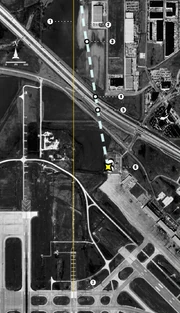
The flight path in the final moments. William Mayberry is k!lled in his car at "4". 1.) Extended Centerline, 2.) Estimated flight path, 3.) point of initial impact at 18:05:52, 4.) point where flight impacts a street light and k!ll driver William Mayberry on Texas State Highway 114, 5.) point where the aircraft departs the highway, knocking down two more street lights, and begins to disintegrate, 6.) the water tanks where most of the fuselage is destroyed, 7.) the threshold of runway 17L at DFW
Crash[ ]
At 18:03:46, once again, the approach controller instructed Flight 191 to decrease its speed, this time to 150 knots (170 mph), and subsequently handed over control to the tower controller. Within twelve seconds, the captain radioed the tower, stating, "Tower[:] Delta one ninety-one heavy, out here in the rain, feels good." The tower controller informed Flight 191 about a 5-knot (5.8 mph; 2.6 m/s) wind with gusts reaching up to 15 knots (17 mph; 7.7 m/s), to which the captain acknowledged. The flight crew initiated preparations for landing by lowering the landing gear and extending the flaps.
At 18:04:18, First Officer Price remarked, "Lightning coming out of that one. ... Right ahead of us." The captain announced their altitude as 1,000 feet (300 m) at 18:05:05, cautioning Price to monitor airspeed fourteen seconds later. Simultaneously, the cockpit voice recorder (CVR) captured the onset of a sound identified as rain hitting the cockpit. The captain forewarned Price, stating, "You're gonna lose it all of a sudden, there it is." At 18:05:26, he instructed Price, "Push it up, push it way up." Subsequently, the CVR recorded the sound of the engines spooling up, with Connors concluding, "That's it," at 18:05:36. From this juncture, the aircraft initiated a descent from which recovery proved unattainable. The angle of attack (AOA) exceeded 30° and exhibited erratic variations over the next few seconds.[4] The pitch angle began to decline, and the aircraft descended below the glideslope.[5]
Striking a highway street light, the aircraft's nose gear made contact with the westbound lane of Highway 114, skidding at a speed of at least 200 miles per hour (170 kn; 320 km/h). Tragically, the left engine collided with a Toyota Celica driven by 28-year-old William Mayberry, resulting in his instantaneous death. Continuing its course southward, the aircraft collided with two additional street lights on the eastbound side of the highway, initiating a fragmentation process. The left horizontal stabilizer, various engine components, sections of the wing control surfaces, and segments of the nose gear separated from the aircraft as it continued along the ground. Witnesses reported the emergence of fire from the left wing root, and surviving passengers recounted the onset of fire within the cabin while the plane was still in motion.
Survivors described passengers attempting to escape the fire by unbuckling their seatbelts and fleeing, some tragically being drawn out of the plane, while others who remained caught fire due to leaking jet fuel. One survivor credited their survival to being doused by rain from openings in the plane. The aircraft's trajectory over open land concluded with a collision into two water tanks situated on the edge of the airport property. The aircraft first grazed one water tank approximately 1,700 feet (520 m) south of Highway 114 before striking the second one. Upon impact with the water tanks, the left-wing and nose of the aircraft led to a counterclockwise rotation, ultimately resulting in the engulfment of the fuselage in a fireball.[4]
Post-crash Response[ ]
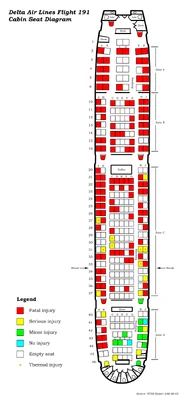
A diagram of the cabin and injuries to passengers and flight attendants of the crashed Delta Air Lines Flight 191.
Within one minute of the crash, all airport fire and emergency units were put on alert. Just 45 seconds after the initial alert, three fire trucks from the airport's fire station No. 3 arrived at the crash site and promptly engaged in firefighting efforts. Additional units from fire stations No. 1 and No. 2 reached the scene within five minutes. Despite challenging conditions marked by high wind gusts and heavy rain, the fire was effectively brought under control within 10 minutes of the initial alert being sounded.[4]
The first paramedics, arriving within five minutes of the crash, swiftly set up triage stations. As per later testimony provided to NTSB officials, on-site EMTs estimated that without the implementation of on-scene triage procedures, at least half of the surviving passengers would have perished. Most survivors of Flight 191 were situated in the aircraft's rear smoking section, which had separated from the main fuselage upon impact with the water tanks. Authorities transported the majority of survivors to Parkland Memorial Hospital.
[1] [2] [3] [4] [5]
- ↑ https://en.m.wikipedia.org/wiki/Delta_Air_Lines_Flight_191
- ↑ https://simpleflying.com/delta-air-lines-flight-191-anniversary/
- ↑ https://www.sun-sentinel.com/1985/10/01/delta-crew-sensed-trouble-transcript-traces-last-minutes-of-flight-191/
- ↑ https://www.nytimes.com/1985/10/01/us/crew-in-dallas-saw-bad-weather-ahead.html
- ↑ https://www.youtube.com/watch?v=HY7pH3fzsvY
Note
The crash of Flight 191 resulted in the tragic loss of 137 lives, encompassing 136 individuals on board the aircraft—comprising the entire flight crew (three members), five cabin crew members, and 128 passengers—and one person on the ground. This tally includes two passengers who initially survived the crash but succumbed to their injuries later. On October 4, 1985, more than two months after the crash, the 137th and final fatality occurred when a burned passenger, who had also undergone dual leg amputations, passed away. It's noteworthy that although media reports consistently cited a total of 137 fatalities stemming from the crash, the NTSB's conclusive report identified only 135 as "fatal" injuries.
The NTSB clarified in its final report that federal regulations specify a "fatal injury" as one resulting in death within 30 days of an accident. Consequently, the last two passengers to succumb to their injuries, which occurred more than 30 days after the accident, were categorized as "survivors" in accordance with regulatory requirements.